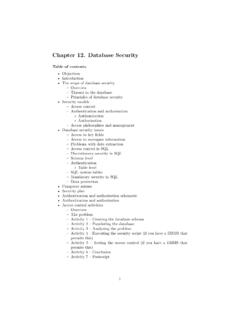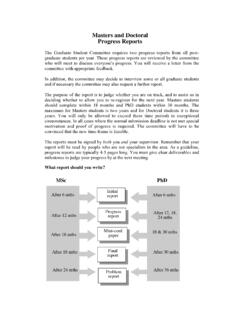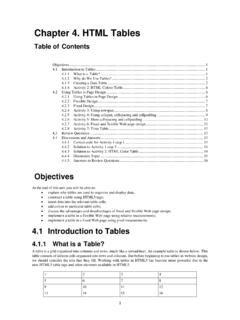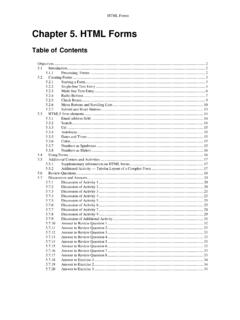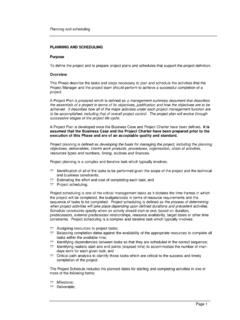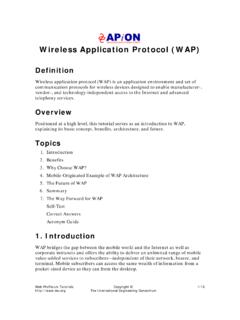Transcription of Chapter 13. Concurrency Control
1 Chapter 13. Concurrency ControlTable of contents Objectives Introduction Context Concurrent access to data concept of transaction Transaction states and additional operations Interleaved Concurrency Interleaved vs simultaneous Concurrency Genuine vs appearance of Concurrency Read and write operations Need for Concurrency Control The lost update problem Uncommitted dependency (or dirty read / temporary update) Inconsistent analysis Other problems Need for recovery Transaction problems Desirable properties of transactions (ACID) Atomicity Consistency Isolation Durability or permanency Serialisability Schedules of transactions Serial schedules Non-serial schedules Serialisable schedule Locking techniques for Concurrency Control Types of locks Binary locks Shared and exclusive locks Use of the locking scheme Guaranteeing serialisability by two-phase locking (2PL)
2 Basic 2PL Conservative 2PL Strict 2PL Dealing with deadlock and livelock Deadlock detection with wait-for graph Ordering data items deadlock prevention protocol Wait-die or wound-wait deadlock prevention protocol Livelock Discussion topics1 Discussion topic 1 Discussion topic 2 Discussion topic 3 Additional content and exercises Additional content Concurrency Control based on timestamp ordering Multiversion Concurrency Control techniques Multiversion techniques based on timestamp ordering Multiversion two-phase locking Granularity of data items Additional exercises Extension exercise 1 Extension exercise 2 Extension exercise 3 Extension exercise 4 ObjectivesAt the end of this Chapter you should be able to: Describe the nature of transactions and the reasons for designing databasesystems around transactions.
3 Explain the causes of transaction failure. Analyse the problems of data management in a concurrent environment. Critically compare the relative strengths of different Concurrency parallel with this Chapter , you should read Chapter 20 of Thomas Connollyand Carolyn Begg, database Systems A Practical Approach to Design, Imple-mentation, and Management , (5th edn.).The purpose of this Chapter is to introduce the fundamental technique of con-currency Control , which provides database systems with the ability to handlemany users accessing data simultaneously.
4 In addition, this Chapter helps youunderstand the functionality of database management systems, with special ref-erence to online transaction processing (OLTP). The Chapter also describes theproblems that arise out of the fact that users wish to query and update storeddata at the same time, and the approaches developed to address these problems,together with their respective strengths and weaknesses in a range of are a number of concepts that are technical and unfamiliar. You will beexpected to be able to handle these concepts but not to have any knowledgeof the detailed algorithms involved.
5 This Chapter fits closely with the one onbackup and recovery, so you may want to revisit this Chapter later in the courseto review the concepts. It will become clear from the information on concurrencycontrol that there are a number of circumstances where recovery procedures mayneed to be invoked to salvage previous or currently executing transactions. Thematerial covered here will be further extended in the Chapter on distributeddatabase systems, where we shall see how effective Concurrency Control can beimplemented across a computer criteria can be used to classify DBMSs, one of which is the number ofusers supported by the system .
6 Single-user systems support only one user at atime and are mostly used with personal computers. Multi-user systems, whichinclude the majority of DBMSs, support many users this Chapter , we will discuss the Concurrency Control problem, which occurswhen multiple transactions submitted by various users interfere with one anotherin a way that produces incorrect results. We will start the Chapter by introducingsome basic concepts of transaction processing. Why Concurrency Control andrecovery are necessary in a database system is then discussed. The concept ofan atomic transaction and additional concepts related to transaction processingin database systems are introduced.
7 The concepts of atomicity, consistency,isolation and durability the so-called ACID properties that are considereddesirable in transactions - are concept of schedules of executing transactions and characterising the recov-erability of schedules is introduced, with a detailed discussion of the concept ofserialisability of concurrent transaction executions, which can be used to definecorrect execution sequences of concurrent will also discuss recovery from transaction failures. A number of concur-rency Control techniques that are used to ensure noninterference or isolationof concurrently executing transactions are discussed.
8 Most of these techniquesensure serialisability of schedules, using protocols or sets of rules that guaranteeserialisability. One important set of protocols employs the technique of lockingdata items, to prevent multiple transactions from accessing the items concur-rently. Another set of Concurrency Control protocols use transaction timestamp is a unique identifier for each transaction generated by the Control protocols that use locking and timestamp ordering to en-sure serialisability are both discussed in this overview of recovery techniques will be presented in a separate access to dataConcept of transactionThe first concept that we introduce to you in this Chapter is a transaction.
9 Atransaction is the execution of a program that accesses or changes the contentsof a database . It is a logical unit of work (LUW) on the database that is eithercompleted in its entirety (COMMIT) or not done at all. In the latter case, thetransaction has to clean up its own mess, known as ROLLBACK. A transactioncould be an entire program, a portion of a program or a single concept of a transaction is inherently about organising functions to managedata. A transaction may be distributed (available on different physical systemsor organised into different logical subsystems) and/or use data concurrently withmultiple users for different transaction processing (OLTP) systems support a large number of con-current transactions without imposing excessive states and additional operationsFor recovery purposes, a system always keeps track of when a transaction starts,terminates, and commits or aborts.
10 Hence, the recovery manager keeps track ofthe following transaction states and operations: BEGIN_TRANSTRACTION:This marks the beginning of transac-tion execution. READ or WRITE:These specify read or write operations on thedatabase items that are executed as part of a transaction. END_TRANSTRACTION:This specifies that read and write opera-tions have ended and marks the end limit of transaction execution. How-ever, at this point it may be necessary to check whether the changes in-troduced by the transaction can be permanently applied to the database (committed) or whether the transaction has to be aborted because it vio-lates Concurrency Control , or for some other reason (rollback).
